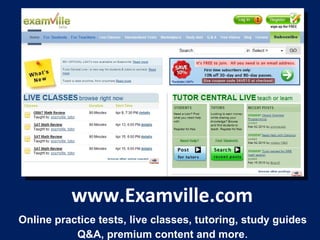
243939 cardiac
- 1. www.Examville.com Online practice tests, live classes, tutoring, study guides Q&A, premium content and more .
- 2. THE CARDIOVASCULAR SYSTEM THE HEART AS A PUMP
- 8. END- DIASTOLIC VOLUME - volume of blood filling the ventricle During rapid filling = 110ml to 120ml - 130 ml STROKE VOLUME - volume of blood ejected as he ventricles contract During systole = 70ml to 90 ml END -SYSTOLIC VOLUME - remaining volume in each ventricle = 40 - 50 ml PRELOAD - degree of tension on the muscle when it begins to contract End Diastolic Volume = 110 to 120 - 130ml EJECTION FRACTION - fraction of the end -diastolic volume that is ejected = 60% to 65% volume
- 9. AFTERLOAD - load against which the muscle exerts its contractile force - pressure in the artery leading from the ventricle ABSOLUTE REFRACTORY PERIOD Ventricle - 0.25 to 0.3 second Atrium - 0.15 second RELATIVE REFRACTORY PERIOD - 0.05 second Causes of Plateau in Cardiac Action Potential 1. Opening of slow calcium - sodium channels 2. Decreased potassium permeability CARDIAC OUTPUT - the quantity of blood pumped into the aorta each minute by the heart VENOUS RETURN- quantity of blood flowing from the veins into the right atrium each minute
- 10. CARDIAC CYCLE EVENTS I. LATE DIASTOLE A. Rapid Filling - 70 to 80% from atria to ventricle B. Slow Filling - Diastasis C. Atrial Systole - 30 to 20% from atria to ventricle II. SYSTOLE (Ventricular) A. Isometric Ventricular Contraction Right ventricle pressure above 10 mmHg Left ventricular pressure above 80 mmHg B. Rapid Ejection - 70% of blood from ventricle to aorta and pulmonary artery C. Slow Ejection - 30% of blood from ventricle to aorta and pulmonary artery
- 11. III. EARLY DIASTOLE A. Protodiastole B. Isometric Ventricular Relaxation ATRIAL PRESSURE WAVES a wave - caused by atrial contraction Right atrial pressure increases 4 to 6 mmHg Left atrial pressure increases 7 to 8 mmHg c wave - back bulging of A - V valves when ventricles contract v wave - slow flow of blood into the atria from the veins while A-V valves are closed during ventricular contraction Efficiency of the Heart or Efficiency of cardiac Contraction - ratio of work output to total chemical energy expenditure Normal Heart - 20 to 25 %
- 12. VARIATION IN LENGTH OF ACTION POTENTIAL AND ASSOCIATED PHENOMENA WITH CARDIAC RATE
- 13. EFFECT OF VARIOUS CONDITIONS ON CARDIAC OUTPUT. APPROXIMATE PERCENTAGE CHANGES ARE SHOWN IN PARENTHESIS
- 15. REGULATION OF CARDIAC PUMPING A. BASIC MEANS of regulating volume pumped by the heart. 1. Intrinsic Cardiac Regulation of pumping in response to changes of volume of blood flowing to the hear. FRANK - STARLING MECHANISM - the greater the heart is stretched during filling, the greater the force of contraction and the greater the quantity of blood pumped into the aorta HETEROMETRIC REGULATION - regulation of cardiac output as a result of changes in cardiac muscle fiber length. 2. Control of the Heart by the Sympathetic and Parasympathetic nerves
- 16. Changes in Cardiac output caused by nerve stimulation result from changes in heart rate and from changes in contractile strength of the heart Chronotropic Action - cardiac accelerator action of catecholamines Inotropic Action - effect on strength of cardiac contraction Homometric Regulation - regulation due to changes in contractility independent of length.
- 17. B. Other Factors: 1. Effect of Potassium and Calcium Ions Excess potassium in the ECF causes the heart to become dilated and flacid and slows the heart rate Excess calcium ions causes the heart to go into Spastic contraction 2. Effect of temperature on Heart Function Increased temperature caused greatly increased heart rate
- 21. Catecholamines exert their inotropic effect by activation of adenylyl cyclase and increase intracellular cAMP Xanthines such as caffeine and theophylline - inhibit the breakdown of cAMP Glucagon - increases the formation of cAMP - is positively inotropic Digitalis - inhibitory effect on Na + - K + ATPase in the myocardium - is positively inotropic Hypercapnia,hypoxia, acidosis, barbiturates - decrease myocardial contractility - are positively inotropic.
- 25. HEART SOUNDS AND MURMURS
- 42. It’s FREE to join. http://www.examville.com